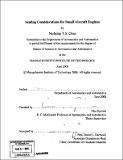Scaling considerations for small aircraft engines
Author(s)
Chan, Nicholas Y. S
DownloadFull printable version (18.30Mb)
Other Contributors
Massachusetts Institute of Technology. Dept. of Aeronautics and Astronautics.
Advisor
Alan Epstein.
Terms of use
Metadata
Show full item recordAbstract
Small aircraft engines traditionally have poorer performance compared to larger engines, which until recently, has been a factor that outweighed the aerodynamic benefits of commoditized and distributed propulsion. Improvements in the performance of small engines have, however, prompted another look at this old concept. This thesis examines aspects of aircraft engines that may have application to commodity thrust or distributed propulsion applications. Trends of engine performance with size and time are investigated. These trends are further extended to justify parameter choices for conceptual engines of the current, mid-term (10 years) and far-term (20 years). Uninstalled and installed performances are evaluated for these engines, and parametric studies are performed to determine the most influential and limiting factors. It is found that scaling down of engines is detrimental to SFC and fuel burn, mainly due to the Reynolds number effect. The more scaling done, the more prominent the effect. It is determined that new technology such as higher TIT, OPR and turbomachinery [eta]poly's for small aircraft engines enable the operation of larger bypass ratios, which is the most influential parameter to SFC and fuel bum. The increase of bypass ratio up to a value of 8 is found to be effective for such improvement. SFC decrease from the current to mid-term model is found to be ~20% and ~9% from mid-term to far-term. Range and endurance improvements are found to be ~30% and ~10% respectively for the mission examined. Finally, the mid-term engine model has performance comparable to that of a current, larger state-of-the-art engine, thus suggesting that improvement in small gas turbine technology in the next 10 years will make the application of commodity thrust or distributed propulsion an attractive option for future aircraft.
Description
Thesis (S.M.)--Massachusetts Institute of Technology, Dept. of Aeronautics and Astronautics, 2008. Includes bibliographical references (p. 81-84).
Date issued
2008Department
Massachusetts Institute of Technology. Department of Aeronautics and AstronauticsPublisher
Massachusetts Institute of Technology
Keywords
Aeronautics and Astronautics.